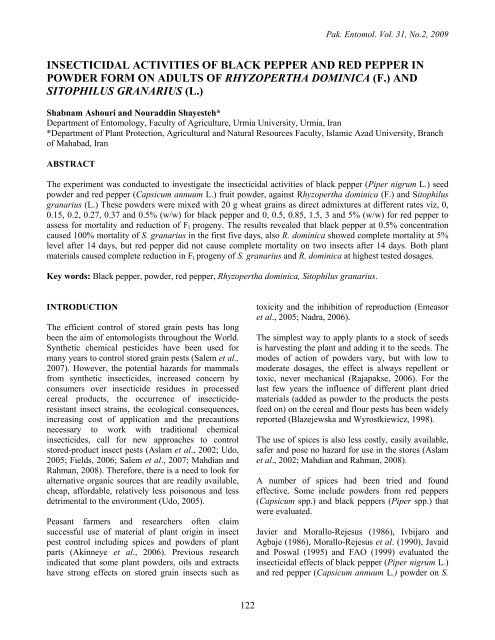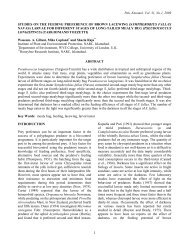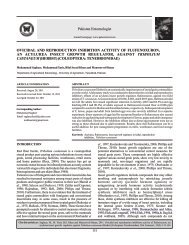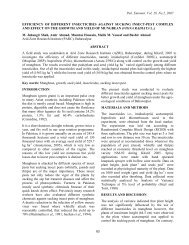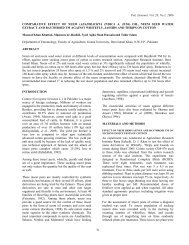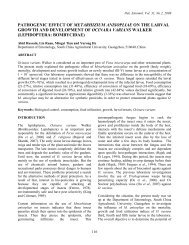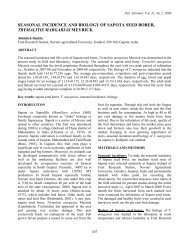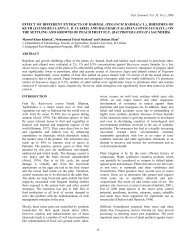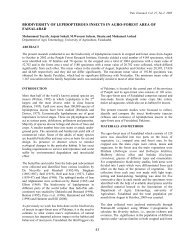insecticidal activities of black pepper and red pepper in powder form ...
insecticidal activities of black pepper and red pepper in powder form ...
insecticidal activities of black pepper and red pepper in powder form ...
- No tags were found...
Create successful ePaper yourself
Turn your PDF publications into a flip-book with our unique Google optimized e-Paper software.
Pak. Entomol. Vol. 31, No.2, 2009<br />
INSECTICIDAL ACTIVITIES OF BLACK PEPPER AND RED PEPPER IN<br />
POWDER FORM ON ADULTS OF RHYZOPERTHA DOMINICA (F.) AND<br />
SITOPHILUS GRANARIUS (L.)<br />
Shabnam Ashouri <strong>and</strong> Nouradd<strong>in</strong> Shayesteh*<br />
Department <strong>of</strong> Entomology, Faculty <strong>of</strong> Agriculture, Urmia University, Urmia, Iran<br />
*Department <strong>of</strong> Plant Protection, Agricultural <strong>and</strong> Natural Resources Faculty, Islamic Azad University, Branch<br />
<strong>of</strong> Mahabad, Iran<br />
ABSTRACT<br />
The experiment was conducted to <strong>in</strong>vestigate the <strong><strong>in</strong>secticidal</strong> <strong>activities</strong> <strong>of</strong> <strong>black</strong> <strong>pepper</strong> (Piper nigrum L.) seed<br />
<strong>powder</strong> <strong>and</strong> <strong>red</strong> <strong>pepper</strong> (Capsicum annuum L.) fruit <strong>powder</strong>, aga<strong>in</strong>st Rhyzopertha dom<strong>in</strong>ica (F.) <strong>and</strong> Sitophilus<br />
granarius (L.) These <strong>powder</strong>s were mixed with 20 g wheat gra<strong>in</strong>s as direct admixtures at different rates viz, 0,<br />
0.15, 0.2, 0.27, 0.37 <strong>and</strong> 0.5% (w/w) for <strong>black</strong> <strong>pepper</strong> <strong>and</strong> 0, 0.5, 0.85, 1.5, 3 <strong>and</strong> 5% (w/w) for <strong>red</strong> <strong>pepper</strong> to<br />
assess for mortality <strong>and</strong> <strong>red</strong>uction <strong>of</strong> F l progeny. The results revealed that <strong>black</strong> <strong>pepper</strong> at 0.5% concentration<br />
caused 100% mortality <strong>of</strong> S. granarius <strong>in</strong> the first five days, also R. dom<strong>in</strong>ica showed complete mortality at 5%<br />
level after 14 days, but <strong>red</strong> <strong>pepper</strong> did not cause complete mortality on two <strong>in</strong>sects after 14 days. Both plant<br />
materials caused complete <strong>red</strong>uction <strong>in</strong> F l progeny <strong>of</strong> S. granarius <strong>and</strong> R. dom<strong>in</strong>ica at highest tested dosages.<br />
Key words: Black <strong>pepper</strong>, <strong>powder</strong>, <strong>red</strong> <strong>pepper</strong>, Rhyzopertha dom<strong>in</strong>ica, Sitophilus granarius.<br />
INTRODUCTION<br />
The efficient control <strong>of</strong> sto<strong>red</strong> gra<strong>in</strong> pests has long<br />
been the aim <strong>of</strong> entomologists throughout the World.<br />
Synthetic chemical pesticides have been used for<br />
many years to control sto<strong>red</strong> gra<strong>in</strong> pests (Salem et al.,<br />
2007). However, the potential hazards for mammals<br />
from synthetic <strong>in</strong>secticides, <strong>in</strong>creased concern by<br />
consumers over <strong>in</strong>secticide residues <strong>in</strong> processed<br />
cereal products, the occurrence <strong>of</strong> <strong>in</strong>secticideresistant<br />
<strong>in</strong>sect stra<strong>in</strong>s, the ecological consequences,<br />
<strong>in</strong>creas<strong>in</strong>g cost <strong>of</strong> application <strong>and</strong> the precautions<br />
necessary to work with traditional chemical<br />
<strong>in</strong>secticides, call for new approaches to control<br />
sto<strong>red</strong>-product <strong>in</strong>sect pests (Aslam et al., 2002; Udo,<br />
2005; Fields, 2006; Salem et al., 2007; Mahdian <strong>and</strong><br />
Rahman, 2008). Therefore, there is a need to look for<br />
alternative organic sources that are readily available,<br />
cheap, affordable, relatively less poisonous <strong>and</strong> less<br />
detrimental to the environment (Udo, 2005).<br />
Peasant farmers <strong>and</strong> researchers <strong>of</strong>ten claim<br />
successful use <strong>of</strong> material <strong>of</strong> plant orig<strong>in</strong> <strong>in</strong> <strong>in</strong>sect<br />
pest control <strong>in</strong>clud<strong>in</strong>g spices <strong>and</strong> <strong>powder</strong>s <strong>of</strong> plant<br />
parts (Ak<strong>in</strong>neye et al., 2006). Previous research<br />
<strong>in</strong>dicated that some plant <strong>powder</strong>s, oils <strong>and</strong> extracts<br />
have strong effects on sto<strong>red</strong> gra<strong>in</strong> <strong>in</strong>sects such as<br />
toxicity <strong>and</strong> the <strong>in</strong>hibition <strong>of</strong> reproduction (Emeasor<br />
et al., 2005; Nadra, 2006).<br />
The simplest way to apply plants to a stock <strong>of</strong> seeds<br />
is harvest<strong>in</strong>g the plant <strong>and</strong> add<strong>in</strong>g it to the seeds. The<br />
modes <strong>of</strong> action <strong>of</strong> <strong>powder</strong>s vary, but with low to<br />
moderate dosages, the effect is always repellent or<br />
toxic, never mechanical (Rajapakse, 2006). For the<br />
last few years the <strong>in</strong>fluence <strong>of</strong> different plant dried<br />
materials (added as <strong>powder</strong> to the products the pests<br />
feed on) on the cereal <strong>and</strong> flour pests has been widely<br />
reported (Blazejewska <strong>and</strong> Wyrostkiewicz, 1998).<br />
The use <strong>of</strong> spices is also less costly, easily available,<br />
safer <strong>and</strong> pose no hazard for use <strong>in</strong> the stores (Aslam<br />
et al., 2002; Mahdian <strong>and</strong> Rahman, 2008).<br />
A number <strong>of</strong> spices had been tried <strong>and</strong> found<br />
effective. Some <strong>in</strong>clude <strong>powder</strong>s from <strong>red</strong> <strong>pepper</strong>s<br />
(Capsicum spp.) <strong>and</strong> <strong>black</strong> <strong>pepper</strong>s (Piper spp.) that<br />
were evaluated.<br />
Javier <strong>and</strong> Morallo-Rejesus (1986), Ivbijaro <strong>and</strong><br />
Agbaje (1986), Morallo-Rejesus et al. (1990), Javaid<br />
<strong>and</strong> Poswal (1995) <strong>and</strong> FAO (1999) evaluated the<br />
<strong><strong>in</strong>secticidal</strong> effects <strong>of</strong> <strong>black</strong> <strong>pepper</strong> (Piper nigrum L.)<br />
<strong>and</strong> <strong>red</strong> <strong>pepper</strong> (Capsicum annuum L.) <strong>powder</strong> on S.<br />
122
Pak. Entomol. Vol. 31, No.2, 2009<br />
zeamais, Callosobruchus ch<strong>in</strong>ensis <strong>and</strong> C. maculatus,<br />
respectively.<br />
Aslam et al. (2002) tested six spice <strong>powder</strong>s aga<strong>in</strong>st<br />
C. ch<strong>in</strong>ensis. Clove <strong>and</strong> <strong>black</strong> <strong>pepper</strong> were good<br />
protectants <strong>of</strong> sto<strong>red</strong> chickpea aga<strong>in</strong>st the beetle.<br />
Nadra (2004) showed that Capsicum frutescens<br />
caused high <strong>and</strong> significant mortality (85%) <strong>of</strong><br />
Trogoderma granarium adults at all (1, 2, 4 <strong>and</strong> 6%)<br />
concentrations with<strong>in</strong> 7 days. Oparaeke <strong>and</strong> Bunmi<br />
(2006) showed Piper gu<strong>in</strong>eense <strong>powder</strong> exhibited<br />
acute toxicity on C. sub<strong>in</strong>notatus (Pic.) (Over 90%<br />
mortality <strong>in</strong> all the three concentrations: 2.5, 5.0 <strong>and</strong><br />
7.5% per 150 g seed) assayed <strong>in</strong> 48 h. It also<br />
significantly <strong>red</strong>uced oviposition by 85.44 to 90%<br />
while adult emergence <strong>and</strong> seed damage were<br />
<strong>red</strong>uced by 100% each. Echezona (2006) stated that<br />
dried <strong>and</strong> ground fruits <strong>of</strong> four <strong>pepper</strong> cultivars<br />
(Capsicum spp.) significantly <strong>in</strong>creased adult<br />
mortality <strong>of</strong> C. maculatus (F.) earlier than the no<br />
protectant control. Owoade (2008) conducted an<br />
experiment to expose Dermestes maculatus larvae<br />
(24 - 48 hour old) to three concentrations (15, 20 <strong>and</strong><br />
25gkg -1 ) <strong>of</strong> P. gu<strong>in</strong>ees. Mortalities monito<strong>red</strong> for the<br />
first five days showed that P. gu<strong>in</strong>eese gave mortality<br />
up to 100% at the end <strong>of</strong> 24 hours <strong>and</strong> by the end <strong>of</strong><br />
72 hours, 100% mortality was recorded <strong>in</strong> all three<br />
concentrations. Mahdian <strong>and</strong> Rahman (2008)<br />
<strong>in</strong>vestigated the <strong><strong>in</strong>secticidal</strong> potency <strong>of</strong> some spices<br />
such as <strong>black</strong> <strong>pepper</strong> (P. nigrum), Ceylon c<strong>in</strong>namon<br />
(C<strong>in</strong>namomum zeylanicum), turmeric (Curcuma<br />
longa) <strong>and</strong> <strong>red</strong> <strong>pepper</strong> (C. frutescens), aga<strong>in</strong>st the<br />
pulse beetle, C. maculatus (F.) on sto<strong>red</strong> <strong>black</strong> gram<br />
(Phaseolus bengalensis L.). All the spices were<br />
effective as protectants <strong>of</strong> <strong>black</strong> gram seeds <strong>and</strong> <strong>black</strong><br />
<strong>pepper</strong> was the most effective.<br />
In the present <strong>in</strong>vestigation, the <strong><strong>in</strong>secticidal</strong> activity<br />
<strong>of</strong> <strong>black</strong> <strong>pepper</strong> (Piper nigrum L.) seed <strong>powder</strong> <strong>and</strong><br />
<strong>red</strong> <strong>pepper</strong> (Capsicum annuum L.) fruit <strong>powder</strong> were<br />
evaluated <strong>in</strong> order to determ<strong>in</strong>e their effects on the<br />
mortality <strong>and</strong> progeny production (adult emergence)<br />
<strong>of</strong> two sto<strong>red</strong>-gra<strong>in</strong> <strong>in</strong>sects, the lesser gra<strong>in</strong> borer<br />
(Rhyzopertha dom<strong>in</strong>ica F.) <strong>and</strong> the granary weevil<br />
(Sitophilus granarius L.) <strong>in</strong> wheat gra<strong>in</strong>s under<br />
laboratory conditions.<br />
MATERIALS AND METHODS<br />
The experiments were carried out <strong>in</strong> the Laboratories<br />
<strong>of</strong> the Department <strong>of</strong> Entomology, University <strong>of</strong><br />
Urmia, Iran, dur<strong>in</strong>g 2008-2009.<br />
Preparation <strong>of</strong> plant products & sto<strong>red</strong> gra<strong>in</strong>s: Black<br />
<strong>pepper</strong> (Piper nigrum L.) (Piperaceae) seed <strong>and</strong> <strong>red</strong><br />
<strong>pepper</strong> (Capsicum annuum L.) (Solanaceae) fruit<br />
<strong>powder</strong>s were selected on assumption <strong>of</strong> absence <strong>of</strong><br />
mammalian toxicity ow<strong>in</strong>g to its use as a popular<br />
spice <strong>in</strong> several foods. The <strong>powder</strong>s <strong>and</strong> a local<br />
variety <strong>of</strong> wheat gra<strong>in</strong>s were obta<strong>in</strong>ed from a local<br />
market <strong>in</strong> Urmia, Iran. The <strong>powder</strong>s were sieved with<br />
a 40-mesh sieve to obta<strong>in</strong> a f<strong>in</strong>e dust before<br />
application to the gra<strong>in</strong>s. The spices were sto<strong>red</strong> <strong>in</strong><br />
airtight plastic conta<strong>in</strong>ers at room temperature before<br />
use. Wheat gra<strong>in</strong>s were dis<strong>in</strong>fested by keep<strong>in</strong>g them<br />
<strong>in</strong> a freezer at -18°C for a day <strong>and</strong> subsequently <strong>in</strong><br />
room temperature before be<strong>in</strong>g used for experimental<br />
purposes.<br />
Rear<strong>in</strong>g <strong>of</strong> experimental <strong>in</strong>sects: Local stra<strong>in</strong>s <strong>of</strong> the<br />
granary weevil (Sitophilus granarius L.) <strong>and</strong> the<br />
lesser gra<strong>in</strong> borer (Rhyzopertha dom<strong>in</strong>ica F.) were<br />
rea<strong>red</strong> on un<strong>in</strong>fected whole kernels <strong>of</strong> wheat. Insects<br />
were obta<strong>in</strong>ed from wheat flour factories, Urmia,<br />
Iran. Insects were released at the rate <strong>of</strong> 200 adults <strong>in</strong><br />
jars conta<strong>in</strong><strong>in</strong>g 400 kg <strong>of</strong> wheat gra<strong>in</strong>s. The jars were<br />
cove<strong>red</strong> with musl<strong>in</strong> cloth <strong>and</strong> tied with a rubber<br />
b<strong>and</strong> at open end <strong>and</strong> kept <strong>in</strong> an <strong>in</strong>cubator ma<strong>in</strong>ta<strong>in</strong>ed<br />
at a temperature <strong>of</strong> 28 ± 1°C <strong>and</strong> 70 ± 5% relative<br />
humidity (RH). After two weeks <strong>of</strong> oviposition, the<br />
parent <strong>in</strong>sects were separated <strong>and</strong> egg laid gra<strong>in</strong>s<br />
were ma<strong>in</strong>ta<strong>in</strong>ed <strong>and</strong> re-cultu<strong>red</strong> to produce newly<br />
emerged adults <strong>of</strong> same generation. For this purpose,<br />
the <strong>in</strong>sects emerged after four weeks were removed.<br />
1-14 day old adults <strong>of</strong> S. granarius <strong>and</strong> 1-14 day old<br />
adults <strong>of</strong> R. dom<strong>in</strong>ica were used <strong>in</strong> the experiments.<br />
Mortality <strong>and</strong> progeny assessment assays: Powders<br />
were added separately to 20 g <strong>of</strong> wheat <strong>in</strong> plastic<br />
conta<strong>in</strong>ers (9cm high, 7cm diameter) at five dosages<br />
0.15, 0.2, 0.27, 0.37 <strong>and</strong> 0.5% (w/w) for <strong>black</strong> <strong>pepper</strong><br />
<strong>and</strong> 0.5, 0.85, 1.5, 3 <strong>and</strong> 5% (w/w) for <strong>red</strong> <strong>pepper</strong>,<br />
while the control treatment had no plant seed fruit<br />
<strong>powder</strong>. All treatments were replicated four times.<br />
The test materials were admixed thoroughly <strong>and</strong><br />
gently <strong>in</strong> the conta<strong>in</strong>ers by manual agitation until the<br />
materials were evenly distributed among the gra<strong>in</strong>s<br />
<strong>and</strong> ensure a homogeneous admixture. The contents<br />
<strong>of</strong> the plastic conta<strong>in</strong>ers were allowed to settle down<br />
for about 30 m<strong>in</strong>utes before <strong>in</strong>troduc<strong>in</strong>g adults <strong>in</strong>to<br />
each jar. Twenty adult beetles (1-14 days old for S.<br />
granarius <strong>and</strong> 1-4 days old for R. dom<strong>in</strong>ica) were<br />
<strong>in</strong>troduced <strong>in</strong>to the each conta<strong>in</strong>er. The plastic<br />
123
Pak. Entomol. Vol. 31, No.2, 2009<br />
conta<strong>in</strong>ers were securely cove<strong>red</strong> with white<br />
perforated musl<strong>in</strong> cloth held <strong>in</strong> place with rubber<br />
b<strong>and</strong>s to ensure adequate ventilation. The conta<strong>in</strong>ers<br />
were placed <strong>in</strong> an <strong>in</strong>cubator ma<strong>in</strong>ta<strong>in</strong>ed at a<br />
temperature <strong>of</strong> 28 ± 1°C <strong>and</strong> 70 ± 5 % RH. The<br />
content <strong>of</strong> each <strong>of</strong> the boxes was pou<strong>red</strong> <strong>in</strong> a dish <strong>and</strong><br />
dead <strong>in</strong>sects were counted. Mortality counts <strong>in</strong> each<br />
treatment were recorded after 1, 3, 5, 7 <strong>and</strong> 14 days<br />
(Data were recorded on days to 100% mortality). The<br />
<strong>in</strong>sects were allowed to mate <strong>and</strong> oviposit for 14<br />
days. All adults <strong>in</strong> both treated <strong>and</strong> untreated<br />
conta<strong>in</strong>ers were removed after 14 days <strong>and</strong> the<br />
experiments were monito<strong>red</strong> for the extra 36 days. At<br />
the end <strong>of</strong> the period, the number <strong>of</strong> emerged adults<br />
was counted. Percentage <strong>of</strong> <strong>red</strong>uction <strong>in</strong> progeny<br />
production was determ<strong>in</strong>ed us<strong>in</strong>g Aldryhim’s (1990)<br />
C − T<br />
<strong>form</strong>ula: [ × 100], where:<br />
C<br />
C: Number <strong>of</strong> emerged adults <strong>in</strong> control.<br />
T: Number <strong>of</strong> emerged adults <strong>in</strong> treatment.<br />
Statistical analysis: Data were corrected for<br />
mortalities <strong>in</strong> the control by us<strong>in</strong>g Abbott’s <strong>form</strong>ula<br />
(Abbott, 1925) {[(Sc – St) / Sc] ×100, where Sc = %<br />
survival <strong>in</strong> control while St = % survival <strong>in</strong> treated}<br />
<strong>and</strong> trans<strong>form</strong>ed with an arcs<strong>in</strong> (percentages) method.<br />
Adult emergence data were trans<strong>form</strong>ed with arcs<strong>in</strong><br />
or the square root method. The result<strong>in</strong>g data were<br />
subjected to analysis <strong>of</strong> variance. Analyses <strong>of</strong><br />
Variance (ANOVA) were employed on the data us<strong>in</strong>g<br />
a 2-way ANOVA <strong>of</strong> the MSTAT-C statistical<br />
package. The experimental design for mortality tests<br />
was completely r<strong>and</strong>omized design. The data<br />
obta<strong>in</strong>ed from progeny assays were analyzed<br />
statistically us<strong>in</strong>g r<strong>and</strong>omized complete block design,<br />
one-way ANOVA (P< 0.05). Means <strong>of</strong> the four<br />
replicates <strong>of</strong> treatments were tested by Duncan’s new<br />
multiple range test (DNMR) for significance <strong>of</strong> their<br />
differences.<br />
RESULTS AND DISCUSSION<br />
The results revealed that <strong>black</strong> <strong>pepper</strong> seed <strong>powder</strong><br />
<strong>and</strong> <strong>red</strong> <strong>pepper</strong> fruit <strong>powder</strong> had significant<br />
<strong><strong>in</strong>secticidal</strong> effects on the adults <strong>of</strong> R. dom<strong>in</strong>ica <strong>and</strong><br />
S. granarius as compa<strong>red</strong> to the control. They were<br />
found to be very effective <strong>in</strong> caus<strong>in</strong>g mortality <strong>and</strong><br />
<strong>red</strong>uc<strong>in</strong>g adult emergence <strong>of</strong> both <strong>in</strong>sects. A highly<br />
significant differences (P
Pak. Entomol. Vol. 31, No.2, 2009<br />
Table 1. Mean mortality <strong>of</strong> adults <strong>of</strong> R. dom<strong>in</strong>ica exposed to wheat gra<strong>in</strong>s treated with <strong>black</strong> <strong>pepper</strong> (A) <strong>and</strong><br />
<strong>red</strong> <strong>pepper</strong> (B) <strong>powder</strong>s at different concentrations <strong>and</strong> after different exposure times.<br />
(A)<br />
Dosage<br />
Exposure time [day]<br />
[w/w] 1 3 5 7 14<br />
0.15 3.23±3.23 n 18.44±0.00 kl 27.21±2.63 ij 35.80±5.01 gh 39.09±3.66 fg<br />
0.2 3.23±3.23 n 20.62±1.26 jk 32.33±2.05 ghi 45.02±2.04 ef 53.02±0.74 d<br />
0.27 3.23±3.23 n 24.60±1.80 ijk 36.26±1.23 gh 51.58±1.88 de 58.52±2.09 cd<br />
0.37 11.07±3.91 m 27.35±1.72 ij 37.77±0.86 fgh 56.21±2.71 d 69.42±1.26 b<br />
0.5 12.16±4.67 lm 30.82±0.80 hi 39.98±0.73 fg 63.55±1.47 bc 90.00±0.00 a<br />
(B)<br />
Dosage<br />
Exposure time [day]<br />
[w/w] 1 3 5 7 14<br />
0.5 12.93±0.00 l 15.69±1.59 kl 19.24±2.34 h-l 22.65±1.66 g-k 26.49±1.47 e-i<br />
0.85 12.93±0.00 l 17.07±1.38 jkl 21.28±2.92 g-l 27.44±0.86 e-h 33.93±1.93 de<br />
1.5 18.15±1.59 ijkl 20.62±1.26 g-l 29.01±2.43 efg 32.39±1.51 def 39.20±2.10 cd<br />
3 19.24±2.34 h-l 25.41±2.61 f-j 33.63±4.82 def 39.89±3.25 cd 46.47±1.86 bc<br />
5 21.71±1.09 g-k 34.36±4.64 de 42.79±4.33 c 52.53±4.33 b 60.23±2.46 a<br />
* Means <strong>in</strong> the same box followed by the same letters are not significantly different by Duncan’s multiple range<br />
test at the 5% level (P
Pak. Entomol. Vol. 31, No.2, 2009<br />
Table 3. Mean <strong>red</strong>uction (%) <strong>of</strong> F 1 adult emergence <strong>of</strong> R. dom<strong>in</strong>ica exposed to wheat gra<strong>in</strong>s treated with<br />
<strong>black</strong> <strong>pepper</strong> (A) <strong>and</strong> <strong>red</strong> <strong>pepper</strong> (B) <strong>powder</strong>s at different concentrations after 50 days.<br />
(A)<br />
Dosage [w/w]<br />
0.15 0.2 0.27 0.37 0.5<br />
57.25±0.22 d 65.69±0.12 c 76.48±0.83 b 76.68±0.72 b 80.81±0.27 a<br />
(B)<br />
Dosage [w/w]<br />
0.5 0.85 1.5 3 5<br />
33.40±0.88 d 39.45±0.23 c 47.27±0.26 b 59.02±0.34 a 60.32±0.37 a<br />
* Means <strong>in</strong> the same box followed by the same letters are not significantly different by Duncan’s multiple range<br />
test at the 5% level (P
Pak. Entomol. Vol. 31, No.2, 2009<br />
powde<strong>red</strong> parts <strong>of</strong> pight nigerian plant species<br />
aga<strong>in</strong>st maize weevil Sitophilus zeamais<br />
Motschulsky (Coleoptera: Curculionidae).<br />
Electronic J. Environ. Agric. Food. Chem., 6(11):<br />
2526-2533.<br />
Aslam, M., Kh. A. Khan <strong>and</strong> M. Z. H. Bajwa, 2002.<br />
Potency <strong>of</strong> some spices aga<strong>in</strong>st Callosobruchus<br />
ch<strong>in</strong>ensis L. Onl<strong>in</strong>e J. Biol. Sci., 2(7): 449-452.<br />
Blazejewska, A. <strong>and</strong> K. Wyrostkiewicz, 1998. The<br />
Influence <strong>of</strong> Foeniculum vulgare Fruit Powder.<br />
Electronic J. Pol. Agric. Univ., 1(1): 05.<br />
Donald, A. U., A. A. Gabriel <strong>and</strong> I. O. Emmanuel,<br />
2008. Toxicity <strong>and</strong> oviposition deterrence <strong>of</strong><br />
Piper gu<strong>in</strong>eense (Piperaceae) <strong>and</strong> Monodora<br />
myristica (Annonaceae) aga<strong>in</strong>st Sitophilus<br />
zeamais (Motsch.) on sto<strong>red</strong> maize. J. Entomol.,<br />
Echezona, B. C., 2006. Selection <strong>of</strong> <strong>pepper</strong> cultivars<br />
(Capsicum spp.) for the control <strong>of</strong> bruchids<br />
Callosobruchus maculatus (F.) on sto<strong>red</strong> cowpea<br />
(Vigna unguiculata (L.) Walp.) seeds. Afr. J.<br />
Biotechnol., 5(8): 624-628.<br />
Emeasor, K. C., R. O. Ogbuji <strong>and</strong> S. O. Emosairue,<br />
2005. Insecticidal activity <strong>of</strong> some seed <strong>powder</strong>s<br />
aga<strong>in</strong>st Callosobruchus maculatus (F.)<br />
(Coleoptera: Bruchidae) on sto<strong>red</strong> cowpea. J. Pl.<br />
Dis. Protect., 112(1): 80–87.<br />
FAO, 1999. The Use <strong>of</strong> Spices <strong>and</strong> Medic<strong>in</strong>als as<br />
Bioactive Protectants for Gra<strong>in</strong>s. FAO Agric.<br />
Serv. Bull. No. 137.<br />
Fields, P. G., 2006. Effect <strong>of</strong> Pisum sativum fractions<br />
on the mortality <strong>and</strong> progeny production <strong>of</strong> n<strong>in</strong>e<br />
sto<strong>red</strong>-gra<strong>in</strong> beetles. J. Sto<strong>red</strong> Prod. Res., 42: 86-<br />
96.<br />
Ivbijaro, M. F. <strong>and</strong> M. Agbaje, 1986. Insecticidal<br />
<strong>activities</strong> <strong>of</strong> Piper gu<strong>in</strong>eense Schum <strong>and</strong><br />
Thonn <strong>and</strong> Capsicum species on the cowpea<br />
bruchid, Callosobruchus maculatus F. Insect<br />
Sci. Appl. 74: 521–524.<br />
Javaid, I. <strong>and</strong> M.A.T. Poswal, 1995. Evaluation <strong>of</strong><br />
certa<strong>in</strong> species for the control <strong>of</strong> Callosobruchus<br />
maculatus (Fabricius) (Coleoptera: Bruchidae) <strong>in</strong><br />
cowpea seeds. Afr. Entomol., 3: 87-89.<br />
Mahdian, Sh. H. A. <strong>and</strong> M. Kh. Rahman, 2008.<br />
Insecticidal effect <strong>of</strong> some spices on<br />
Callosobruchus maculatus (Fabricius) <strong>in</strong> <strong>black</strong><br />
gram seeds. Rajshahi Univ. Zool. Soc., 27:<br />
47-50.<br />
Morallo-Rejesus, B. <strong>and</strong> P. A. Javier, 1986.<br />
Determ<strong>in</strong>ation <strong>of</strong> economical medium for mass<br />
rear<strong>in</strong>g <strong>of</strong> <strong>red</strong> flour beetle, Tribolium castaneum<br />
(Herbst) (Coleoptera: Tenebrionidae), as host <strong>of</strong><br />
p<strong>red</strong>atory earwig, Euborellia annulata, (May 8-<br />
10) 17th Ann. PCCP Conference, Iloilo City.<br />
Morallo-Rejesus, B., G. P. Bilog <strong>and</strong> P. A. Javier,<br />
1990. Mass rear<strong>in</strong>g technique <strong>of</strong> Aphytis<br />
l<strong>in</strong>gnanensis Compere , In: Proc. 21st Ann. Conf.<br />
<strong>of</strong> the PCCP, May 7-10, Sugarl<strong>and</strong> Hotel,<br />
Bacolod City.<br />
Nadra, H. A. M., 2004. Test<strong>in</strong>g some various<br />
botanical <strong>powder</strong>s for protection <strong>of</strong> wheat gra<strong>in</strong><br />
aga<strong>in</strong>st Trogoderma granarium Everts. J. Biol.<br />
Sci., 4(5): 592-597.<br />
Nadra, H.A.M., 2006. Use Of Sesbania Sesban (L.)<br />
Merr seed extracts for the protection <strong>of</strong> wheat<br />
gra<strong>in</strong> aga<strong>in</strong>st the granary weevil, Sitophilus<br />
granarius (L.) (Coleoptera: Curculionidae).<br />
Scientific J. K<strong>in</strong>g Faisal Univ., 7(2): 121-135.<br />
Oparaeke, A. M. <strong>and</strong> J. O. Bunmi, 2006. Bioactivity<br />
<strong>of</strong> two powde<strong>red</strong> spices (Piper gu<strong>in</strong>eense Honn<br />
& Schum <strong>and</strong> Xylopia Aethiopica (Dunal) A.<br />
Richard) as home made <strong>in</strong>secticides aga<strong>in</strong>st<br />
Callosobruchus sub<strong>in</strong>notatus (Pic.) on sto<strong>red</strong><br />
Barbara groundnut. Agric. Trop. Subtrop., 39(2):<br />
132-134.<br />
Owoade, R. A., 2008. Mortality, growth <strong>and</strong><br />
development <strong>of</strong> Dermestes maculatus larvae<br />
exposed to dry Clarias sp. treated with four local<br />
spices. Afr. Sci., 9(1): 31-34.<br />
Rajapakse, R. H. S., 2006. The potential <strong>of</strong> plants <strong>and</strong><br />
plant products <strong>in</strong> sto<strong>red</strong> <strong>in</strong>sect pest management.<br />
J. Agric. Sci., 2(1): 11-21.<br />
Salem, S .A., R. G. Abou-Ela, M. M. Matter <strong>and</strong> M.<br />
Y. El-Kholy, 2007. Entomocidal effect <strong>of</strong><br />
Brassica napus extracts on two store pests,<br />
Sitophilus oryzae (L.) <strong>and</strong> Rhizopertha dom<strong>in</strong>ica<br />
(Fab.) (Coleoptera). J. Appl. Sci. Res., 3(4):<br />
317-322.<br />
Udo, I. O., 2005. Evaluation <strong>of</strong> the potential <strong>of</strong> some<br />
local spices as sto<strong>red</strong> gra<strong>in</strong> protectants aga<strong>in</strong>st the<br />
maize weevil Sitophilus zeamais Mots<br />
(Coleoptera: Curculionidae). J. Appl. Sci. Res.<br />
Environ. Manage., 9(1): 165-168.<br />
127


